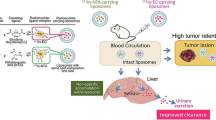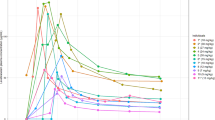Abstract
In previousin vivo studies with mice, rats and cats, we have demonstrated that [11C]MPDX ([1-methyl-11C]8-dicyclopropylmethyl-1-methyl-3-propylxanthine) is a potential radioligand for mapping adenosine A1 receptors of the brain by positron emission tomography (PET). In the present study, we performed a preclinical study. The radiation absorbed-dose by [11C]MPDX in humans estimated from the tissue distribution in mice was low enough for clinical use, and the acute toxicity and mutagenicity of MPDX were not found. The monkey brain was clearly visualized by PET with [11C]MPDX. We have concluded that [11C]MPDX is suitable for mapping adenosine A1 receptors in the human brain by PET.
Similar content being viewed by others
References
Fredholm BB, Abbracchio MP, Burnstock G, Daly JW, Harden TK, Jacobson KA, et al. Nomenclature and classification of purinoceptors.Pharmacol Rev 1994; 46: 143–156.
Palmer TM, Stiles GL. Adenosine receptors.Neuropharmacology 1995; 34: 683–694.
Ongini E, Fredholm BB. Pharmacology of adenosine A2A receptors.Trends Pharmacol Sci 1996; 17: 364–372.
Haas HL, Selbach O. Functions of neuronal adenosine receptors.Naunyn Schmiedebergs Arch Pharmacol 2000; 362: 375–381.
Dunwiddie TV, Masino SA. The role and regulation of adenosine in the central nervous system.Ann Rev Neurosci 2001; 24: 31–55.
von Lubitz DK. Adenosine in the treatment of stroke: yes, maybe, or absolutely not?Expert Opin Investig Drugs 2001; 10: 619–632.
Lewis ME, Patel J, Moon Edley S, Marangos PJ. Autoradiographic visualization of rat brain adenosine receptors usingN 6-cyclohexyl[3H]adenosine.Eur J Pharmacol 1981; 73: 109–110.
Goodman RR, Snyder SH. Autoradiographic localization of adenosine receptors in rat brain using [3H]cyclohexyladenosine.J Neurosci 1982; 2: 1230–1241.
Fastbom J, Pazos A, Palacios JM. The distribution of adenosine A1 receptors and 5′-nucleotidase in the brain of some commonly used experimental animals.Neuroscience 1987; 22: 813–826.
Fastbom J, Pazos A, Probst A, Palacios JM. Adenosine A1 receptors in the human brain: a quantitative autoradiographic study.Neuroscience 1987; 22: 827–839.
Svenningsson P, Hall H, Sedvall G, Fredholm BB. Distribution of adenosine receptors in the postmortem human brain: an extended autoradiographic study.Synapse 1997; 27: 322–335.
Schindler M, Harris CA, Hayes B, Papotti M, Humphrey PP. Immunohistochemical localization of adenosine A1 receptors in human brain regions.Neurosci Lett 2001; 297: 211–215.
Mally J, Stone TW. Potential role of adenosine antagonist therapy in pathological tremor disorders.Pharmacol Ther 1996; 72: 243–250.
Ishiwata K, Furuta R, Shimada J, Ishii S, Endo K, Suzuki F, et al. Synthesis and preliminary evaluation of [11C]KF15372, a selective adenosine A1 antagonist.Appl Radiat Isot 1995; 46: 1009–1013.
Furuta R, Ishiwata K, Kiyosawa M, Ishii S, Saito N, Shimada J, et al. Carbon-11 labeled KF15372: a potential central nervous system adenosine A1 receptor ligand.J Nucl Med 1996; 37: 1203–1207.
Noguchi J, Ishiwata K, Furuta R, Shimada J, Kiyosawa M, Ishii S, et al. Evaluation of carbon-11 labeled KF15372 and it's ethyl and methyl derivatives as a potential CNS adenosine A1 receptor ligand.Nucl Med Biol 1997; 24: 53–59.
Wakabayashi S, Nariai T, Ishiwata K, Nagaoka T, Hirakawa K, Oda K, et al. A PET study of adenosine A1 receptor in anesthetized monkey brain.Nucl Med Biol 2000; 27: 401–406.
Shimada Y, Ishiwata K, Kiyosawa M, Nariai T, Oda K, Toyama H, et al. Mapping adenosine A1 receptors in the cat brain by positron emission tomography with [11C]MPDX.Nucl Med Biol 2002; 29: 29–37.
Kiyosawa M, Ishiwata K, Noguchi J, Endo K, Wang WF, Suzuki F, et al. Neuroreceptor bindings and synaptic activity in visual system of monocularly enucleated rat.Jpn J Ophthalmol 2001; 45: 264–269.
Shimada Y, Nariai T, Ishiwata K, Ishii S, Oda K, Ando M, et al. Decrease in adenosine A1 receptor binding potential after reperfusion as a predictor of severe cerebral ischemic insult—PET multitracer study in cats' model of transient MCA occlusion.J Cereb Blood Flow Metab 1999; 19: S249.
Shimada J, Suzuki F, Nonaka H, Karasawa A, Mizumoto H, Ohno T, et al. 8-(Dicyclopropylmethyl)-1,3-dispropylxanthine: a potent and selective adenosine A1 antagonist with renal protective and diuretic activities.J Med Chem 1991; 34: 466–469.
Suzuki F, Shimada J, Mizumoto H, Karasawa A, Kubo K, Nonaka H, et al. Adenosine A1 antagonists. 2. Structure-activity relationships on diuretic activities and protective effects against acute renal failure.J Med Chem 1992; 35: 3066–3075.
Suzuki F, Shimada J, Shiozaki S, Ichikawa S, Ishii A, Nakamura J, et al. Adenosine A1 antagonists. 3. Structure-activity relationships on amelioration against scopolamine-orN 6-(R-phenylisopropyl)adenosine-induced cognitive disturbance.J Med Chem 1993; 36: 2508–2518.
Ishiwata K, Ido T, Mejia AA, Ichihashi M, Mishima Y. Synthesis and radiation dosimetry of 4-borono-2-[18F]fluoro-D,L-phenylalanine: A target compound for PET and boron neutron capture therapy.Appl Radiat Isot 1991; 142: 325–328.
Mejia AA, Nakamura T, Itoh M, Hatazawa J, Ishiwata K, Ido T, et al. Absorbed dose estimates in positron emission tomography studies based on the administration of18F-labeled radiopharmaceuticals.J Radiat Res 1991; 32: 243–261.
Watanabe M, Uchida H, Okada H, Shimizu K, Satoh N, Yoshikawa E, et al. A high resolution PET for animal studies.IEEE Trans Med Imag 1992; 11: 577–580.
Jansen K, Faull RLM, Dragunow M, Synek BJL. Alzheimer's disease: changes in hippocampalN-methyl-d-aspartate, quisqualate, neurotensin, adenosine, benzodiazepine, serotonin and opioid receptors—an autoradiographic study.Neuroscience 1990; 39: 613–627.
Ulas J, Brunner LC, Nguyen L, Cotman CW. Reduced density of adenosine A1 receptors and preserved coupling of adenosine A1 receptors to G proteins in Alzheimer hippocampus: a quantitative autoradiographic study.Neuroscience 1993; 52: 843–854.
Angelatou F, Pagonopoulou O, Maraziotis T, Olivier A, Villemeure JG, Avoli M, et al. Upregulation of A1 adenosine receptors in human temporal lobe epilepsy: a quantitative autoradiographic study.Neurosci Lett 1993; 163: 11–14.
Author information
Authors and Affiliations
Corresponding author
Rights and permissions
About this article
Cite this article
Ishiwata, K., Nariai, T., Kimura, Y. et al. Preclinical studies on [11C]MPDX for mapping adenosine A1 receptors by positron emission tomography. Ann Nucl Med 16, 377–382 (2002). https://doi.org/10.1007/BF02990074
Received:
Accepted:
Issue Date:
DOI: https://doi.org/10.1007/BF02990074




